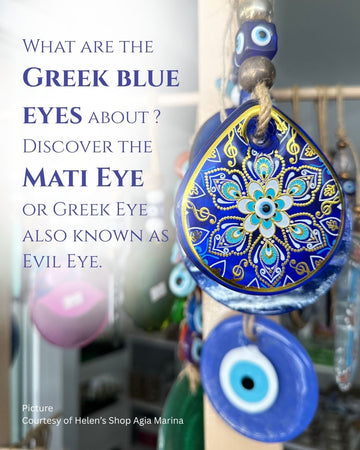ANCIENT WISDOM FOR MODERN DAY LIFE
What are the Greek blue eyes about? Discover the Mati Eye or Greek Eye also known as Evil Eye.

GREEK SYMBOLS AND MYTH
When visiting Greece, you will likely be surprised and intrigued by the abundance of blue eyes in shops. You might think it's a tourist trap, but it is not. The Mati Eye, also known as the Greek Eye, is a very ancient tradition.
According to Wikipedia, the symbol dates back at least 5000 years.
Early evidence of the evil eye's existence is found in Sumerian cuneiform and amulets, indicating that its origins spread across the Mediterranean from Mesopotamia.
What’s Behind the Greek Eye? Beliefs, Fears, Human Evolution, and Heart-Centred Wishes
In Greece, it has long been believed that jealousy, envy, or desire—whether intentional or not—could cast a harmful spell on someone. To protect against this, family members or friends will gift you a Mati (Greek Eye, also known as an Evil Eye charm) to ward off negative energy and safeguard your well-being.
According to tradition, however, such curses only have power if you believe in them.
Still, even today, a well-meaning compliment—on a child’s beauty, someone's good fortune, or personal charm—can be seen as a potential invitation for the evil eye.
Philosophically, one could say this fear stems from collective life experience. Greek mythology, for example, is filled with stories where beauty and talent attracted danger, especially for women and children. Unlike their more average-looking counterparts, beautiful women were said to be prone to catch the unwanted attention of gods like Zeus, who, much like Gilgamesh in Mesopotamia or warlords of later times, exercised a so-called “Lord’s Right” over young women, whether virginal or married.
Later on, as pirates and soldiers from successive empires swept through the region, beauty again became a source of risk of rape, kidnapping, or being sold into slavery. These fears weren’t just about aesthetics; they touched on the very real dangers to physical integrity, particularly for women and children. Wealth was also a source of risk of looting or death, if not both. Power was risky, as there would always be someone wanting to be the ruler above the one in place.
The Library of Apollodorus notes that in ancient Greece, boys were sometimes dressed as girls to protect them from harm; perhaps to preserve the family line, or to prevent them from being taken by imperial powers for slave labour or conscription.
Over generations, this survival instinct crystallised over fear of curses led by ill-intention or unspoken jealousies. The Mati Eye became the amulet one would use to deflect these negative energies.
There is more to the Greek Eye or Mati Eye than the crystallisation of fears: there is love and self-care too.
During the latest millennium, the Mati Eye tradition might have been rooted in fear but also in love. It is a gift you make to friends and family to welcome new neighbours or wish success to a new business owner. When offering it, you wish someone the best, love, health, and abundant resources.
But there is more. If we were to flip the coin on our perspectives, rather than fear, we could play with what energies we want to call in.
Let's imagine that Mati Eye could be more than a protective talisman. What if it could simply reflect the person looking at it?
In this case, the ill-intended person would see their behaviour and actions. The holder of the Mati Eye would also see their reflection and thus have a good look at themselves too. The Mati Eye would then become a window to your own soul making you face your good and bad side.
The danger of beauty could be vanity; thus, the Mati Eye reminds us to always embody humility. The risk of prosperity is greed, so the Greek Eye reminds us of the importance of altruism, a sense of community, and generosity. Jealousy calls for compassion and respect. Power games call for co-creation, support, and solidarity.
Looking at the talisman from this perspective, the Mati Eye could become your moral compass.
OUR MATI EYE PRODUCTS
-
What are the Greek blue eyes about? Discover the Mati Eye or Greek Eye also known as Evil Eye.
When visiting Greece, you will likely be surprised and intrigued by the abund...
-
Ferry Schedule for Agia Marina, Aegina Island, Greece – Your Ultimate Guide 2025
Ferry Schedule for Agia Marina to enjoy your Day trip to Aegina from Athens, ...
-
The Marti Bracelet: Discover a Greek tradition to welcome Spring.
The Marti Bracelet: DISCOVER A GREEK SPRING TRADITION, find an easy-to-follow...








